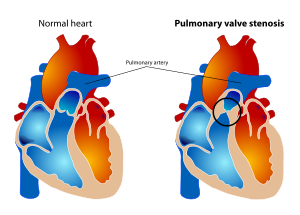Pulmonary valve stenosis
| Pulmonary valve stenosis | |
|---|---|
| Other names: Valvular pulmonary stenosis, pulmonic stenosis | |
 | |
| Specialty | Cardiology |
| Symptoms | Few symptoms initially, may develop syncope, chest pain, and shortness of breath[1] |
| Causes | Congenital heart disease, carcinoid syndrome[2] |
| Diagnostic method | Suspected based on a systolic murmur, confirmed by ultrasound of the heart[2] |
| Treatment | Balloon valvuloplasty, valve replacement[1] |
| Prognosis | Generally good[2] |
| Frequency | 0.4% at birth[3] |
Pulmonary valve stenosis (PVS) is a type of heart valve disease in which there is narrowing of the pulmonary valve opening.[4] Affected children often have no symptoms.[2] When symptoms develop these may include syncope, chest pain, or shortness of breath.[2]
The most common cause is congenital heart disease such as tetralogy of Fallot and Noonan syndrome.[2] Other causes include carcinoid syndrome.[2] The narrowing may occur at, above, or below the valve and results in obstruction of blood flow to the pulmonary artery.[1] Diagnosis may be suspected based on a systolic murmur and confirmed by ultrasound of the heart.[2]
Treatment may may include balloon valvuloplasty and valve replacement.[2] Outcomes are generally good.[2] At birth it affected about 4 per 1,000 people.[3] It accounts for around 10% of heart deformities present at birth.[1] Initial descriptions of the condition at birth date from 1761 by John Baptist Morgagni.[5] Surgical repair was first carried out in 1953.[5]
Signs and symptoms

Symptoms may include tiredness, shortness of breath, feeling faint and chest pain.[1] There may be an abnormal jugular venous pressure, a systolic murmur, clubbing, and blue coloured skin.[1]
Cause
In regards to the cause of pulmonary valve stenosis a very high percentage are congenital, the right ventricular flow is hindered (or obstructed by this). The cause in turn is divided into: valvular, external and intrinsic (when it is acquired).[6]
Both stenosis of the pulmonary artery and pulmonary valve stenosis are forms of pulmonic stenosis (nonvalvular and valvular, respectively)[7] but pulmonary valve stenosis accounts for 80% of pulmonic stenosis.
Pathophysiology
The pathophysiology of pulmonary valve stenosis consists of the valve leaflets becoming too thick (therefore not separate one from another), which can cause high pulmonary pressure, and pulmonary hypertension. This however, does not mean the cause is always congenital.[8]
The left ventricle can be changed physically, these changes are a direct result of right ventricular hypertrophy. Once the obstruction is subdued, it (the left ventricle) can return to normal.[9]
Diagnosis
The diagnosis of pulmonary valve stenosis can be achieved via echocardiogram, as well as a variety of other means among them are: ultrasound, in which images of the heart chambers in utero where the tricuspid valve has thickening (or due to Fallot's tetralogy, Noonan's syndrome, and other congenital defects) and in infancy auscultation of the heart can reveal identification of a murmur.[10]
Some other conditions to contemplate (in diagnosis of pulmonic valvular stenosis) are the following:[11]
- Infundibular stenosis
- Supravalvular pulmonary stenosis
- Dysplastic pulmonic valve stenosis
Treatment
In terms of treatment for pulmonary valve stenosis, valve replacement or surgical repair (depending upon whether the stenosis is in the valve or vessel) may be indicated. If the valve stenosis is of congenital origin, balloon valvuloplasty is another option, depending on the case. Valves made from animal or human tissue (are used for valve replacement), in adults metal valves can be used.[12][13]
Epidemiology
At birth it affected about 4 per 1,000 people.[3] It accounts for around 8% to 10% of all heart deformities.[1]
References
- ↑ 1.0 1.1 1.2 1.3 1.4 1.5 1.6 Khna, Fazal W.; Çoçek, M. Sertaç (2020). "97. Pulmonary valve stenosis". In Raja, Shahzad G. (ed.). Cardiac Surgery: A Complete Guide. Switzerland: Springer. pp. 885–889. ISBN 978-3-030-24176-6. Archived from the original on 2022-10-16. Retrieved 2022-10-15.
- ↑ 2.0 2.1 2.2 2.3 2.4 2.5 2.6 2.7 2.8 2.9 "Pulmonic Stenosis - Cardiovascular Disorders". Merck Manuals Professional Edition. Archived from the original on 28 October 2020. Retrieved 23 December 2020.
- ↑ 3.0 3.1 3.2 Benjamin, Ivor; Griggs, Robert C.; Fitz, J. Gregory (2015). Andreoli and Carpenter's Cecil Essentials of Medicine E-Book. Elsevier Health Sciences. p. 72. ISBN 978-0-323-35236-9. Archived from the original on 2021-08-29. Retrieved 2020-12-24.
- ↑ "Congenital heart disease - Types". nhs.uk. 19 October 2017. Archived from the original on 20 September 2017. Retrieved 24 December 2020.
- ↑ 5.0 5.1 Satpathy, M. (2015). Clinical Diagnosis of Congenital Heart Disease. JP Medical Ltd. p. 197. ISBN 978-93-5152-912-5. Archived from the original on 2021-08-29. Retrieved 2020-12-24.
- ↑ Wang, Andrew; Bashore, Thomas M. (2010-01-14). Valvular Heart Disease. Springer Science & Business Media. p. 266. ISBN 9781597454117. Archived from the original on 2016-06-09. Retrieved 2015-11-18.
- ↑ Ren, XM; et al. (2014-12-23), "Pulmonic stenosis", Medscape, archived from the original on 2016-03-14, retrieved 2016-03-10.
- ↑ Levine, Shel; Coyne, Brian J.; Colvin, Lisa Cooper (2015-02-13). Clinical Exercise Electrocardiography. Jones & Bartlett Publishers. p. 14. ISBN 9781284034202. Archived from the original on 2021-08-29. Retrieved 2019-01-07.
- ↑ "Valvar Pulmonary Stenosis: Background, Pathophysiology, Epidemiology". 2018-06-07. Archived from the original on 2009-03-12. Retrieved 2009-05-07.
{{cite journal}}: Cite journal requires|journal=(help) - ↑ "Pulmonary Valve Disease. About Pulmonary valve disease | Patient". Patient. Archived from the original on 2020-04-05. Retrieved 2015-11-18.
- ↑ "Pulmonic Valvular Stenosis Clinical Presentation: History, Physical, Causes". emedicine.medscape.com. Archived from the original on 2015-12-28. Retrieved 2015-11-18.
- ↑ Choices, NHS. "Congenital heart disease - Treatment - NHS Choices". www.nhs.uk. Archived from the original on 2015-11-18. Retrieved 2015-11-18.
- ↑ "Balloon dilatation of pulmonary valve stenosis | Guidance and guidelines | NICE". www.nice.org.uk. Archived from the original on 2015-11-19. Retrieved 2015-11-18.
External links
| Classification | |
|---|---|
| External resources |